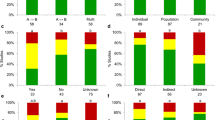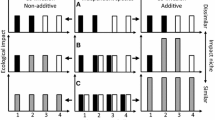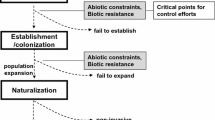Abstract
The potential role of positive interactions among co-invaders is at the core of the invasional meltdown hypothesis. The interaction of non-native species could result in an exacerbation of each other’s effects. Thus, the resulting effect of multiple non-native species on ecosystems can be greater than the sum of their individual effects. We designed an analytical framework and a set of mesocosm experiments to assess the potential synergistic effects of three non-native species (Limnoperna fortunei, Astronotus crassipinnis, and Hydrilla verticillata) in a highly invaded floodplain in southern Brazil. We analyzed ecosystem, community, and population attributes in scenarios with non-natives. Our hypothesis of a synergistic effect was not supported. Even though effects of the invasive species were detected for all ecological levels, evidence indicated that these effects were additive. In addition to adding to the statement that origin (i.e., native vs. non-native status) does matter, we provide a tool to differentiate additive, synergistic, and antagonistic effects in situations with multiple invasions, and experimentally demonstrate additive effects of non-native species at different ecological levels.






Similar content being viewed by others
References
Abbott, K. L. & P. T. Green, 2007. Collapse of an ant-scale mutualism in a rainforest on Christmas Island. Oikos 116: 1238–1246.
Agostinho, A. A., L. C. Gomes, S. Veríssimo & E. K. Okada, 2004. Flood regime, dam regulation and fish in the Upper Paraná River: effects on assemblage attributes, reproduction and recruitment. Reviews in Fish Biology and Fisheries 14: 11–19.
Agostinho, A. A., S. M. Thomaz, L. C. Gomes & S. L. S. M. A. Baltar, 2007. Influence of the macrophyte Eichhornia azurea on fish assemblage of the Upper Paraná River floodplain (Brazil). Aquatic Ecology 41: 611–619.
Blois, J. L., P. L. Zarnetske, M. C. Fitzpatrick & S. Finnegan, 2013. Climate change and the past, present, and future of biotic interactions. Science 341: 499–504.
Boltovskoy, D. & N. Correa, 2015. Ecosystem impacts of the invasive bivalve Limnoperna fortunei (golden mussel) in South America. Hydrobiologia 746: 81–95.
Borenstein, M., L. V. Hedges, J. P. T. Higgins & H. R. Rothstein, 2009. Introduction to Meta-analysis. Wiley, Chichester.
Bottrell, H. H., A. Duncan, Z. M. Gliwicz, E. Gryiek, A. Herzig, A. Hillbricht-Ilkowska, H. Kurasawa, P. Larsson & T. Weglenska, 1976. A review of some problems in zooplankton production studies. Norwegian Journal of Zoology 24: 419–456.
Braga, R. R., L. Gómez-Aparicio, T. Heger, J. R. S. Vitule & J. M. Jeschke, 2018a. Invasional meltdown hypothesis. In Jeschke, J. M. & T. Heger (eds), Invasion Biology: Hypotheses and Evidence. CAB International, Oxfordshire: 79–91.
Braga, R. R., L. Gómez-Aparicio, T. Heger, J. R. S. Vitule & J. M. Jeschke, 2018b. Structuring evidence for invasional meltdown: broad support but with biases and gaps. Biological Invasions 20: 923–936.
Brown, J. H., T. G. Whitham, S. K. M. Ernest & C. A. Gehring, 2001. Complex species interactions and the dynamics of ecological systems: long-term experiments. Science 293: 643–650.
Cantanhêde, G., N. S. Hahn, E. A. Gubiani & R. Fugi, 2008. Invasive molluscs in the diet of Pterodoras granulosus (Valenciennes, 1821) (Pisces, Doradidae) in the Upper Paraná River floodplain, Brazil. Ecology of Freshwater Fish 17: 47–53.
Catford, J. A., M. Bode & D. Tilman, 2018. Introduced species that overcome life history tradeoffs can cause native extinctions. Nature Communications 9: 2131.
Cox, J. G. & S. L. Lima, 2006. Naiveté and an aquatic-terrestrial dichotomy in the effects of introduced predators. Trends in Ecology and Evolution 21: 674–680.
de Oliveira, C. R. C., R. Fugi, K. P. Brancalhão & A. A. Agostinho, 2010. Fish as potential controllers of invasive mollusks in a Neotropical reservoir. Natureza & Conservação 8: 140–144.
Dodds, W. K., S. A. Higgs, M. J. Spangler, J. Guinnip, J. D. Scott, S. C. Hedden, B. D. Frenette, R. Taylor, A. E. Schechner, D. J. Hoeinghaus & M. A. Evans-White, 2018. Spatial heterogeneity and controls of ecosystem metabolism in a Great Plains River Network. Hydrobiologia 813: 85–102.
dos Santos, D. A., D. J. Hoeinghaus & L. C. Gomes, 2018. Spatial scales and the invasion paradox: a test using fish assemblages in a Neotropical floodplain. Hydrobiologia 817: 121–131.
Duchini, D., D. Boltovskoy & F. Sylvester, 2018. The invasive freshwater bivalve Limnoperna fortunei in South America: multiannual changes in its predation and effects on associated benthic invertebrates. Hydrobiologia 817: 431–446.
Elton, C. S., 1958. The Ecology of Invasions by Animals and Plants. Methuen, London.
Flory, S. L. & J. T. Bauer, 2014. Experimental evidence for indirect facilitation among invasive plants. Journal of Ecology 102: 12–18.
Froese, R. & D. Pauly, 2018. FishBase. World Wide Web electronic publication [available on internet at www.fishbase.org]. Accessed June 2018.
Gallardo, B., M. Clavero, M. I. Sánchez & M. Vilà, 2016. Global ecological impacts of invasive species in aquatic ecosystems. Global Change Biology 22: 151–163.
Gao, H., Y. Song, C. Lv, X. Chen, H. Yu, J. Peng & M. Wang, 2015. The possible allelopathic effect of Hydrilla verticillata on phytoplankton in nutrient-rich water. Environmental Earth Sciences 73: 5141–5151.
García, M. L. & L. C. Protogino, 2005. Invasive freshwater molluscs are consumed by native fishes in South America. Journal of Applied Ichthyology 21: 34–38.
Golterman, H. L., R. S. Clyno & M. A. M. Ohnstad, 1978. Methods for Physical and Chemical Analysis of Freshwaters. Blackwell, Oxford.
Green, P. T., D. J. O’Dowd, K. L. Abbott, M. Jeffery, K. Retallick & R. Mac Nally, 2011. Invasional meltdown: invader–invader mutualism facilitates a secondary invasion. Ecology 92: 1758–1768.
Gubiani, É. A., R. Ruaro, V. R. Ribeiro, A. C. A. Eichelberger, R. F. Bogoni, A. D. Lira, D. Cavalli, P. A. Piana & W. J. da Graça, 2018. Non-native fish species in Neotropical freshwaters: how did they arrive, and where did they come from? Hydrobiologia 817: 57–69.
Jackson, M. C., T. Jones, M. Milligan, D. Sheath, J. Taylor, A. Ellis, J. England & J. Grey, 2014. Niche differentiation among invasive crayfish and their impacts on ecosystem structure and functioning. Freshwater Biology 59: 1123–1135.
Jeschke, J. M. & T. Heger, 2018. Synthesis. In Jeschke, J. M. & T. Heger (eds), Invasion Biology: Hypotheses and Evidence. CAB International, Oxfordshire: 157–166.
Johnson, P. T. J., J. D. Olden, C. T. Solomon & M. J. Vander Zanden, 2009. Interactions among invaders: community and ecosystem effects of multiple invasive species in an experimental aquatic system. Oecologia 159: 161–170.
Júlio Júnior, H. F., C. D. Tós, Â. A. Agostinho & C. S. Pavanelli, 2009. A massive invasion of fish species after eliminating a natural barrier in the Upper Rio Paraná Basin. Neotropical Ichthyology 7: 709–718.
Kuebbing, S. E. & M. A. Nuñez, 2016. Invasive non-native plants have a greater effect on neighbouring natives than other non-natives. Nature Plants 2: 16134.
Kuehne, L. M. & J. D. Olden, 2012. Prey naivety in the behavioural responses of juvenile Chinook salmon (Oncorhynchus tshawytscha) to an invasive predator. Freshwater Biology 57: 1126–1137.
Lambertini, M., J. Leape, J. Marton-Lefèvre, R. A. Mittermeier, M. Rose, J. G. Robinson, S. N. Stuart, B. Waldman & P. Genovesi, 2011. Invasives: a major conservation threat. Science 333: 404–405.
Latini, A. O. & M. Petrere Jr., 2004. Reduction of a native fish fauna by alien species: an example from Brazilian freshwater tropical lakes. Fisheries Management and Ecology 11: 71–79.
Meza-Lopez, M. M. & E. Siemann, 2015. Experimental test of the Invasional Meltdown Hypothesis: an exotic herbivore facilitates an exotic plant, but the plant does not reciprocally facilitate the herbivore. Freshwater Biology 60: 1475–1482.
Michelan, T. S., M. J. Silveira, D. K. Petsch, G. D. Pinha & S. M. Thomaz, 2014. The invasive aquatic macrophyte Hydrilla verticillata facilitates the establishment of the invasive mussel Limnoperna fortunei in Neotropical reservoirs. Journal of Limnology 73: 598–602.
O’Dowd, D. J., P. T. Green & P. S. Lake, 2003. Invasional “meltdown” on an Oceanic Island. Ecology Letters 6: 812–817.
O’Loughlin, L. S. & P. T. Green, 2015. Invader–invader mutualism influences land snail community composition and alters invasion success of alien species in tropical rainforest. Biological Invasions 17: 2659–2674.
Ota, R. R., G. C. Deprá, W. J. Graça & C. S. Pavanelli, 2018. Peixes da planície de inundação do alto rio Paraná e áreas adjacentes: revised, annotated and updated. Neotropical Ichthyology 16: e170094.
Paolucci, E. M., D. H. Cataldo, C. M. Fuentes & D. Boltovskoy, 2007. Larvae of the invasive species Limnoperna fortunei (Bivalvia) in the diet of fish larvae in the Paraná River, Argentina. Hydrobiologia 589: 219–233.
Paolucci, E. M., H. J. MacIsaac & A. Ricciardi, 2013. Origin matters: alien consumers inflict greater damage on prey populations than do native consumers. Diversity and Distributions 19: 988–995.
Pelicice, F. M., A. A. Agostinho & S. M. Thomaz, 2005. Fish assemblages associated with Egeria in a tropical reservoir: investigating the effects of plant biomass and diel period. Acta Oecologica 27: 9–16.
Ribas, L. G. S., E. R. Cunha, J. R. S. Vitule, R. P. Mormul, S. M. Thomaz & A. A. Padial, 2017. Biotic resistance by snails and fish to an exotic invasive aquatic plant. Freshwater Biology 62: 1266–1275.
Rosenberg, M. S., D. C. Adams & J. Gurevitch, 1997. MetaWin: Statistical Software for Meta-analysis with Resampling Tests. Sinauer Associates, Sunderland.
Ross, D. J., C. R. Johnson, C. L. Hewitt & G. M. Ruiz, 2004. Interaction and impacts of two introduced species on a soft-sediment marine assemblage in SE Tasmania. Marine Biology 144: 747–756.
Seebens, H., T. M. Blackburn, E. E. Dyer, P. Genovesi, P. E. Hulme, J. M. Jeschke, S. Pagad, P. Pyšek, M. Winter, M. Arianoutsou, S. Bacher, B. Blasius, G. Brundu, C. Capinha, L. Celesti-Grapow, W. Dawson, S. Dullinger, N. Fuentes, H. Jäger, J. Kartesz, M. Kenis, H. Kreft, I. Kühn, B. Lenzner, A. Liebhold, A. Mosena, D. Moser, M. Nishino, D. Pearman, J. Pergl, W. Rabitsch, J. Rojas-Sandoval, A. Roques, S. Rorke, S. Rossinelli, H. E. Roy, R. Scalera, S. Schindler, K. Štajerová, B. Tokarska-Guzik, M. Van Kleunen, K. Walker, P. Weigelt, T. Yamanaka & F. Essl, 2017. No saturation in the accumulation of alien species worldwide. Nature Communications 8: 14435.
Simberloff, D., 2004. Community ecology: is it time to move on? The American Naturalist 163: 787–799.
Simberloff, D., 2006. Invasional meltdown 6 years later: important phenomenon, unfortunate metaphor, or both? Ecology Letters 9: 912–919.
Simberloff, D. & J. R. S. Vitule, 2014. A call for an end to calls for the end of invasion biology. Oikos 123: 408–413.
Simberloff, D. & B. Von Holle, 1999. Positive interactions of nonindigenous species. Biological Invasions 1: 21–32.
Simberloff, D., J. L. Martin, P. Genovesi, V. Maris, D. A. Wardle, J. Aronson, F. Courchamp, B. Galil, E. García-Berthou, M. Pascal, P. Pyšek, R. Sousa, E. Tabacchi & M. Vilà, 2013. Impacts of biological invasions: what’s what and the way forward. Trends in Ecology and Evolution 28: 58–66.
Sinistro, R., 2010. Top-down and bottom-up regulation of planktonic communities in a warm temperate wetland. Journal of Plankton Research 32: 209–220.
Skóra, F., V. Abilhoa, A. A. Padial & J. R. S. Vitule, 2015. Darwin’s hypotheses to explain colonization trends: evidence from a quasi-natural experiment and a new conceptual model. Diversity and Distributions 21: 583–594.
Sousa, W. T. Z., 2011. Hydrilla verticillata (Hydrocharitaceae), a recent invader threatening Brazil’s freshwater environments: a review of the extent of the problem. Hydrobiologia 669: 1–20.
StatSoft, Inc., 2005. STATISTICA (Data Analysis Software System), Version 7.1 [available on internet at www.statsoft.com]. Accessed 25 May 2018.
Sutherland, W. J., M. J. Bailey, I. P. Bainbridge, T. Brereton, J. T. A. Dick, J. Drewitt, N. K. Dulvy, N. R. Dusic, R. P. Freckleton, K. J. Gaston, P. M. Gilder, R. E. Green, A. L. Heathwaite, S. M. Johnson, D. W. MacDonald, R. Mitchell, D. Osborn, R. P. Owen, J. Pretty, S. V. Prior, H. Prosser, A. S. Pullin, P. Rose, A. Stott, T. Tew, C. D. Thomas, D. B. A. Thompson, J. A. Vickery, M. Walker, C. Walmsley, S. Warrington, A. R. Watkinson, R. J. Williams, R. Woodroffe & H. J. Woodroof, 2008. Future novel threats and opportunities facing UK biodiversity identified by horizon scanning. Journal of Applied Ecology 45: 821–833.
Tonella, L. H., R. Fugi, O. B. Vitorino, H. I. Suzuki, L. C. Gomes & A. A. Agostinho, 2018. Importance of feeding strategies on the long-term success of fish invasions. Hydrobiologia 817: 239–252.
Utermöhl, H., 1958. Zur Vervollkommnung der quantitativen Phytoplankton-Methodik. Internationale Vereinigung für Theoretische und Angewandte Limnologie 26: 11–20.
Vitule, J. R. S., F. Skóra & V. Abilhoa, 2012. Homogenization of freshwater fish faunas after the elimination of a natural barrier by a dam in Neotropics. Diversity and Distributions 18: 111–120.
Von Holle, B., 2011. Invasional meltdown. In Simberloff, D. & M. Rejmánek (eds), Encyclopedia of Biological Invasion. University of California Press, Berkeley: 360–364.
White, E. M., J. C. Wilson & A. R. Clarke, 2006. Biotic indirect effects: a neglected concept in invasion biology. Diversity and Distributions 12: 443–455.
Acknowledgements
This research was partially supported by CAPES (Coordenação de Aperfeiçoamento de Pessoal de Nível Superior), an Organ of the Brazilian Government for training of human resources. CAPES provided scholarships to R.R. Braga, V. M. Ribeiro, I. P. Affonso, J. Wojciechowski, L. G.S. Ribas, and V. Tiburcio. E. R. Cunha was supported by Grant of the Parque tecnológico ITAIPU. J. R. S. Vitule, A. A. Padial, and S. M. Thomaz acknowledge the Brazilian Council of Research (CNPq) for Research Grants associated with several scientific projects. We would also like to thank R. D. Zenni, M. S. Dechoum, K. M. Campião, L. C. Gomes, and V. Abilhoa for helpful suggestions on the manuscript. We thank James A. Nienow for providing English writing revision. Field work would not be possible without the support of F. A. Frehse, V. S. Daga, S. Pereto, E. Silva, F. Ceschin, P. Dall’ Agnol, S. Rodrigues, A. S. Silva, and V. F. Souza, therefore we are thankful.
Author information
Authors and Affiliations
Corresponding author
Additional information
Publisher's Note
Springer Nature remains neutral with regard to jurisdictional claims in published maps and institutional affiliations.
Guest editors: Koen Martens, Sidinei M. Thomaz, Diego Fontaneto & Luigi Naselli-Flores / Emerging Trends in Aquatic Ecology III
Electronic supplementary material
Below is the link to the electronic supplementary material.
Rights and permissions
About this article
Cite this article
Braga, R.R., Ribeiro, V.M., Padial, A.A. et al. Invasional meltdown: an experimental test and a framework to distinguish synergistic, additive, and antagonistic effects. Hydrobiologia 847, 1603–1618 (2020). https://doi.org/10.1007/s10750-019-04107-x
Received:
Revised:
Accepted:
Published:
Issue Date:
DOI: https://doi.org/10.1007/s10750-019-04107-x




